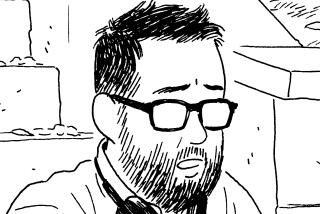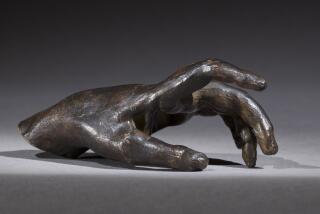Miriam Katin’s graphic novel is portrait of an artist’s inner life
- Share via
Miriam Katin’s “Letting It Go” (Drawn & Quarterly: 160 pp., $24.95) is my kind of graphic memoir: loose, impressionistic, a portrait of the artist’s inner life. Keyed by the decision of her adult son Ilan to take up permanent residence in Berlin, it is, in part, the story of her coming to terms, at long last, with her legacy as a survivor of the Holocaust.
But without minimizing this part of the story, “Letting It Go” is much more than that — a meditation on love, on family, and an inquiry into art. Functioning in some sense as a sketchbook, Katin’s story is delightfully open-ended, less a look back at a particular situation than a series of reflections from the trenches of her life as it is lived.
Katin opens the book with a riff on procrastination, quoting Proust (“Ten times over, I must essay the task, must lean down over the abyss. And each time the natural laziness which deters us from every difficult enterprise … has urged me to leave the thing alone and drink my tea and to think merely of the worries of today … which let themselves be pondered without effort or distress of mind”) from “Swann’s Way.” It’s an ingenius strategy, establishing her work in a tradition of literary self-reflection, a point she deepens by invoking Kafka’s “The Metamorphosis,” as well.
For Katin, these are touchstones, expressions of humanity that stand in contrast to the inhumanity she faced during World War II. They are also metaphors for the intractability of her project (both artistic and personal) and the importance of art not as something rarefied but as a fundamental expression of what it means to be alive.
The inclusion of Kafka is especially instructive, for Katin must undergo a metamorphosis of her own. When Ilan tells her that he plans not only to live in Berlin, but to apply for Hungarian citizenship, it is as if she has been cast back to her childhood: “Over my dead body! They wanted to kill us!” she declares.
Still, as the book progresses, Katin has no choice but to confront her unresolved hurts, her biases, and contrast them to her devotion to her son. “Listen Miriam,” a friend tells her. “You are not protecting him. If he wants to live there, he will anyway.”
This is the point of “Letting It Go” — that we have no control. We are at the mercy of our experience, of our children, and all we can do is try to come to terms. It’s an idea Katin explored in her first graphic memoir, “We Are on Our Own,” which traced her experiences during the war.
“Letting It Go” grows out of that book, adapting its rough-hewn, largely black and white aesthetic in places, when Katin looks back on her past. More often, though, she opts for a careening style, color drawings cascading one upon the other in a flurry of movement and light.
There are no panels here, just images that bleed together, as if life were too full, too chaotic, to be bound within the frames of traditional comics art.
It’s exhilarating, making “Letting It Go” a more open work, hopeful even, despite the conflict at its core. This is a book about survival, about perseverence, although it comes to us with no illusions that anything (our relationships, our work, our very selves) is built to last.
Rather, what Katin means to tell us is that all we have is the moment, a moment informed by, but distinct from, both the present and the past. “You think you’ve seen everything,” she writes, “and then you still haven’t.”
The art of living, in other words, is the art of letting go.
ALSO:
Judith Vanistendael’s art of dying
Revisiting David Wojnarowicz’s ‘7 Miles a Second’
Ben Katchor’s askew urban landscape in ‘Hand-Drying in America’
More to Read
Sign up for our Book Club newsletter
Get the latest news, events and more from the Los Angeles Times Book Club, and help us get L.A. reading and talking.
You may occasionally receive promotional content from the Los Angeles Times.







